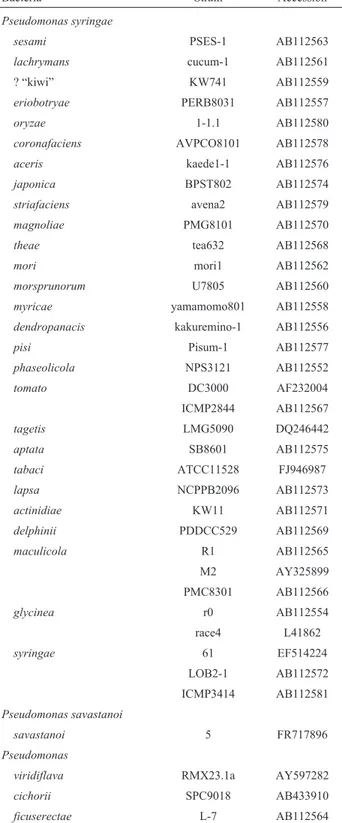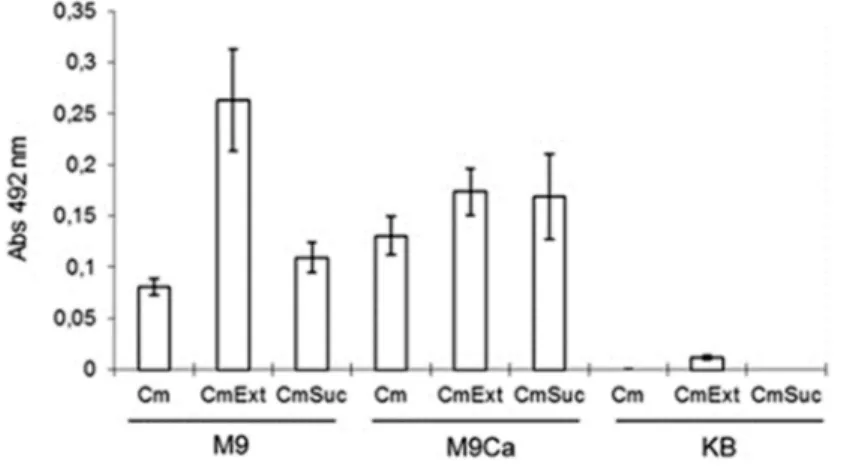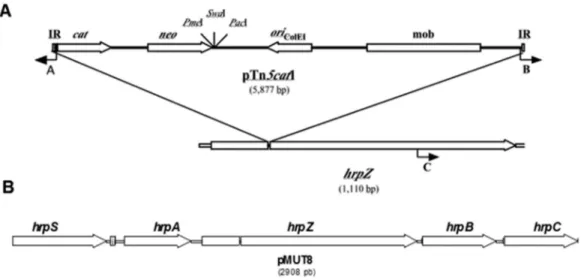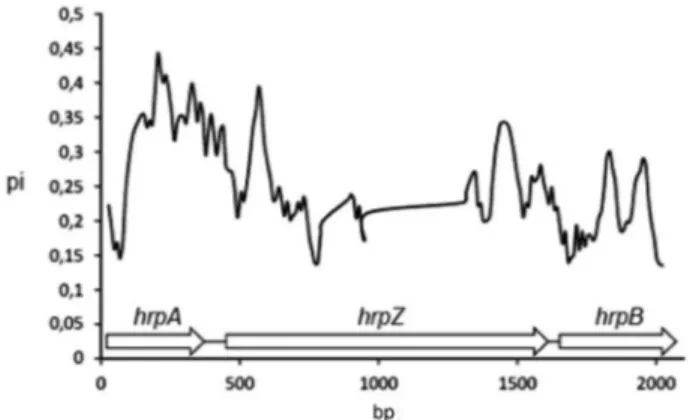Characterization of the
hrpZ
gene from
Pseudomonas syringae
pv.
maculicola
M2
César Álvarez-Mejía
1, Dalia Rodríguez-Ríos
2, Gustavo Hernández-Guzmán
3,
Varinia López-Ramírez
4, Humberto Valenzuela-Soto
5, Rodolfo Marsch
6 1Instituto Tecnológico Superior de Irapuato Plantel Abasolo, Guanajuato, México.2Departamento de Ingeniería Genética de Plantas, Centro de Investigación y de Estudios Avanzados del Instituto Politécnico Nacional, Guanajuato, México.
3División de Ciencias de la Vida, Universidad de Guanajuato, Guanajuato, México. 4Instituto Tecnológico Superior de Irapuato, Guanajuato, México.
5Departamento de Plásticos en Agricultura, Centro de Investigación en Química Aplicada, Coahuila, México
6Departamento de Biotecnología y Bioingeniería, Centro de Investigación y de Estudios Avanzados del Instituto Politécnico Nacional, D.F. México, México.
Submitted: August 2, 2014; Approved: November 16, 2014.
Abstract
Pseudomonas syringaepv.maculicolais a natural pathogen of members of the Brassicaceae plant family. Using a transposon-based mutagenesis strategy inPseudomonas syringaepv.maculicolaM2 (PsmM2), we conducted a genetic screen to identify mutants that were capable of growing in M9 me-dium supplemented with a crude extract from the leaves ofArabidopsis thaliana. A mutant contain-ing a transposon insertion in the hrpZ gene (PsmMut8) was unable to infect adult plants from Arabidopsis thalianaorBrassica oleracea, suggesting a loss of pathogenicity. The promotorlesscat reporter present in the gene trap was expressed if PsmMut8 was grown in minimal medium (M9) sup-plemented with the leaf extract but not if grown in normal rich medium (KB). We conducted phylo-genetic analysis using hrpAZBgenes, showing the classical 5-clade distribution, and nucleotide diversity analysis, showing the putative position for selective pressure in this operon. Our results in-dicate that thehrpAZBoperon fromPseudomonas syringaepv.maculicolaM2 is necessary for its pathogenicity and that its diversity would be under host-mediated diversifying selection.
Key words:hrpZ, mutant non-pathogenic, transmid, Tn5, phylogenetic.
Introduction
The majority of Gram-negative pathogenic bacteria are endowed with the type III secretion system, which is a highly conserved apparatus that exports proteins that are essential to induce disease (Deaneet al., 2006; Tanget al., 2006; Mansfield, 2009). Exported proteins play an impor-tant role in disease development at the cellular level. In phytopathogenic bacteria, the apparatus is called the Hrp system and is encoded by the hrp gene cluster (h yper-sensitivityresponse andpathogenicity) (Alfano and Col-lmer, 2004; Block and Alfano, 2011), which is usually included in a pathogenicity island (Gropp and Guttman, 2004). The product of these genes is a structure resembling
a straight flagellum (Jinet al., 2001; Arnoldet al., 2011), of which the Hrp pilus contacts the plant cell surface during infection (Büttner, 2012). Two types of proteins are expor-ted through the Hrp pili: theavr(avirulence) gene products and the “harpins,” which are products of thehrpZandhrpW genes (Reboutier and Bouteau, 2008; Schumacheret al., 2014). Avr proteins appear to be injected into plant cells (Jinet al., 2001; Fuet al., 2006), where they modulate the cell metabolism to export nutrients to the apoplast (van Dijket al., 1999). In an incompatible interaction, the Avr protein is recognized by the product of a gene for resis-tance,R, which triggers the hypersensitive response and re-sults in disease abortion (Mansfield, 2009). The harpins are
DOI: http://dx.doi.org/10.1590/S1517-838246320140655
Send correspondence to R. Marsch. Departamento de Biotecnología y Bioingeniería, Cinvestav. Avenida I.P.N 2508, Colonia San Pedro Zacatenco, 07360. México, D.F. México. E-mail: rmarsch@cinvestav.mx.
encoded byhrpgenes but are not included in thehrppilus structure; instead, they are secreted into the medium or the apoplast, where they perform their activity. The function of harpins is not fully known (Choiet al., 2013). There are contradictory reports regarding HrpZ being essential (Heet al., 1993) or not (Preston, 2000) for pathogenesis.
In this work, the function of thehrpZgene fromP. syringae pv. maculicola strain M2 (PsmM2) was inter-rupted using a transposable element promoter probe. The mutant strain was unable to infect adult plants from Arabidopsis thaliana or Brassica oleracea, indicating a complete loss of bacterial pathogenicity. The PsmM2hrpZ gene is almost identical to its homolog inPseudomonas syringaepv.tomatoDC3000, suggesting that pathovars are conserved among distinct susceptible plant species. Our re-sults suggest thathrpZis an essential gene that is necessary for bacterial infection in plants.
Materials and Methods
Bacterial strains, plants and plasmids
Pseudomonas syringae pv. maculicola strain M2 (RifR) was a kind gift from Dr. Jeffrey L. Dangl (Ritter and Dangl, 1995), and PsmMut8 was obtained in this work.E. coliS17-1lpir (thi pro hsdR hsdMDrecARP4-2traTc::Mu Km::Tn7) (de Lorenzoet al., 1990) was obtained from Dr. Kate J. Wilson. E. coli DH5a competent cells (supE44 DlacU169(f80lacZDM15)hsdR17 recA1 endA1 gyrA96 thi-1 relA1) (Sambrook and Russell, 2001) were used for cloning experiments. ASwaI restriction site was added into theSmaI site on pUIRM504 (Marsch-Morenoet al., 1998) to form the plasmid pMDC505 (unpublished results); with this change, the transposable element pTn5cat (Marsch-Morenoet al., 1998) was modified into pTn5cat1.King’s B medium (Kinget al., 1954), minimal medium M9 (Sam-brook and Russell, 2001) or M9CA (Difco) was used to cul-tureP. s. maculicolastrains and in the assay to determine the conditions forcatexpression, with or without the addi-tions described below. LB medium was used to culture the E. colistrains. Chloramphenicol, rifampicin and kanamy-cin were purchased from Serva or Sigma-Aldrich Chemi-cals.
Mutagenesis and mutant selection
Mutants of PsmM2 were generated using the transmid element pTn5cat1 according a published protocol (Marsch-Morenoet al., 1998).E. coli S17-1 (pMDC505) was used to mobilize pTn5cat1 to PsmM2 by conjugation, and the bacteria were then spread onto M9 Rif50 Km50 plates. Mutants were screened for their ability to growth on M9 Cm50with plant extract. To obtain crude plant extract, mature rosette leaves from 3-week-old Arabidopsis thalianaplants were frozen in liquid nitrogen and ground into a powder, which was then centrifuged at 13,000 rpm
for 10 to 20 min. The liquid phase was recovered and added to the growth medium as an effector of pathogenesis.
Assay for promoter strength
The promoter strength was evaluated as the cell den-sity after the bacteria were grown in a medium containing chloramphenicol (Alvarez-Mejiaet al., 2013). The assays were performed in sterile 96-well polystyrene plates. First, 50mL of a 0.04-OD620culture of mutant PsmMut8 in KB Km50was added to wells containing 200mL of M9, M9Ca or KB medium supplemented or not with plant extract (2mL/mL) or sucrose (5%); all media contained kanamycin (50mg/mL) and chloramphenicol (150mg/mL). The plates were incubated at 28 °C, and the cell density was measured at 0, 24 and 48 h using a Titertek Multiskan Plus (EFLAB, Joint Venture Company of Lab System and Flow Labora-tories) with a 492-nm filter.
Pathogenesis assays
To test the ability of the mutants to induce disease in A. thaliana, 3-week-old plants were inoculated by infiltra-tion with mutant or wild type PsmM2 cell suspensions (~20mL per leaf). The cell suspensions were prepared by growing PsmMut8 or PsmM2 in 5 mL KB, incubated at 28 °C overnight with strong shaking to reach an 0.4 of OD600. Then, 3 mL were centrifuged at 14,000 rpm for 2 min at 4 °C (rotor: Sorvall SS34). The pellet was washed two times with sterile water, and the cells were resuspended in 3 mL of sterile distilled water. Leaves were inoculated with the undiluted cell suspension or with a 1:10 dilution.
Cloning and sequencing
Total PsmMut8 DNA was purified using a previously described method (Chen and Kuo, 1993). First, tenmg of DNA were completely digested using the restriction endo-nucleaseEcoRI in a reaction volume of 50mL. The enzyme was then inactivated at 65 °C for 20 min. Next, 1mg of cut DNA was religated with T4 DNA ligase in a reaction vol-ume of 50mL at 28 °C for 4 h. The ligated DNA was then used to transform competentE. coliDH5acells to become kanamycin resistant. To sequence the cloned chromosomal fragments, oligonucleotides 1212 (5’-GTGCCTGACTGC
GTTA-3’; from the mob end), 1213
(5’-CCTTAGCTCCTGAAA-3’: from thecat end), 1658
(5’-GTTGACCTACGTCAACGCTGGC-3’), 2176
Bioinformatics analysis and alignment
hrpAZBoperons from diverse Pseudomonasstrains were retrieved from the GenBank database and used in our analysis (Table 1). Most of them had been used in a
previ-ous work (Inoue and Takikawa, 2006). Nucleotide poly-morphism analysis was conducted using DnaSP (Rozaset al., 2003), and the sliding window analysis for hrpAZB operon was conducted using 25 nt in a window of 50 nt only for uniqueP. syringaestrains. Bioinformatics analysis was performed using the BLASTn program (Altschul et al., 1990; Worleyet al., 1998), and alignments were performed using Clustal W and edited with BioEdit (Hall, 1999); Pseudomonas viridiflavaandPseudomonas cichoriiwere included as outgroups.
Results
Selection of PsmMut8
A collection of PsmM2 mutants harboring the pTn5cat1 transposon-based construct was screened for the induction of cat expression in M9 medium containing a plant extract (see the Materials and Methods section for de-tails). A total of 14 candidates were identified by their abil-ity to grow in M9 Km50Cm150because the reporter genecat was induced by the plant extract. All of these mutants were tested in pathogenesis assays by inoculatingArabidopsis plants. Mutant number 8 (PsmMut8) was selected because it was unable to infect and cause disease symptoms or hy-persensitivity reaction (HR) in eitherA. thalianaor Bras-sica oleracea(Figure 1).
Promoter expression detected in PsmMut8
Thecatreporter gene in pTn5cat1 allows for the esti-mation of promoter expression under conditions that re-semble those in the apoplast. The cell density in liquid media in the presence of chloramphenicol is associated with the resistance level to the antibiotic, suggesting that the measurement of cell density in the presence of chloram-phenicol in different media (M9, M9Ca or KB) with or without the addition of plant extract or sucrose reflects the expression level of the detected promoter under these con-ditions (Alvarez-Mejiaet al., 2013). The cell density values of PsmMut8 growing in different media at 28 °C after 48 h are shown in Figure 2. The cell density was higher in M9 than in KB medium, suggesting that chloramphenicol resis-tance in response to the plant extract was increased in M9 but that casamino acids preclude the stimulatory effect of the plant extract. No different effects were observed in the assay with sucrose.
pTn5cat1 is inserted into a gene homologous to the
hrpZ gene of Pseudomonas syringae
A 14-kb chromosomal fragment corresponding to the pTn5cat1 borders and their flanking genomic sequences were cloned, sequenced, and compared to the genomic in-formation contained in GenBank. Both flanking sequences are homologous to the hrpZ gene from Pseudomonas syringaepv.tomatoDC3000 (PstDC3000) (99% identity, six nucleotide substitutions over 1,110 bp, Figure 3A). Table 1- Strains used in the phylogenetic analysis. All of the data were
re-trieved from GenBank.
Bacteria Strain Accession
Pseudomonas syringae
sesami PSES-1 AB112563
lachrymans cucum-1 AB112561
? “kiwi” KW741 AB112559
eriobotryae PERB8031 AB112557
oryzae 1-1.1 AB112580
coronafaciens AVPCO8101 AB112578
aceris kaede1-1 AB112576
japonica BPST802 AB112574 striafaciens avena2 AB112579
magnoliae PMG8101 AB112570
theae tea632 AB112568
mori mori1 AB112562
morsprunorum U7805 AB112560
myricae yamamomo801 AB112558
dendropanacis kakuremino-1 AB112556
pisi Pisum-1 AB112577
phaseolicola NPS3121 AB112552
tomato DC3000 AF232004
ICMP2844 AB112567
tagetis LMG5090 DQ246442
aptata SB8601 AB112575
tabaci ATCC11528 FJ946987
lapsa NCPPB2096 AB112573
actinidiae KW11 AB112571
delphinii PDDCC529 AB112569
maculicola R1 AB112565
M2 AY325899
PMC8301 AB112566
glycinea r0 AB112554
race4 L41862
syringae 61 EF514224
LOB2-1 AB112572 ICMP3414 AB112581
Pseudomonas savastanoi
savastanoi 5 FR717896
Pseudomonas
viridiflava RMX23.1a AY597282
cichorii SPC9018 AB433910
Alignment with other sequences reported in GenBank for HrpZ proteins revealed two shared regions between PsmM2 and PstDC3000, including genomic locations 102-125, IGAGGGGGGIGGAGSGSGVGGGLS, and 229-244, SGVTSGGGLGSPVSDS.
Additional sequences flanking pTn5cat1 are similar to thehrpgenes ofPseudomonas syringaeDC3000
To further investigate the location of the interrupted gene in PsMut8, we sequenced the regions upstream and downstream ofhrpZ. All of the generated sequences corre-sponded to previously identified genes encoding Hrp pro-teins:hrpS, hrpA, hrpZ, hrpBandhrpC(Figure 3B). The first and the last open reading frames (ORFs) were only
partially sequenced. A putative hrp box (GGAACCGATT CGCAGGCTGCTGCCACCTA) was identified in the 5’ region ofhrpA(Zwiesler-Vollicket al., 2002), and a puta-tive ribosome binding site (RBS) was identified within the hrpAgene. The 3’-UTRs ofhrpAandhrpZare predicted to fold into hairpin structures reminiscent of bacterial tran-scription terminators (TGAGTACCAAGCAATCACGCT GGTAAATCTTA and GCCCCCTCATCAGAGGGGGC, respectively). The presence of a putative RBS within the terminator suggests that the transcription ofhrpZproceeds independently ofhrpA. To explore a possible conservation of the hrpAZB operon in different pathovars, including PsmM2 and PstDC3000, we conducted a phylogenetic analysis with 35Pseudomonas syringaesequences; 2
dif-Figure 1- Pathogenesis and HR assays for PsmM2 and PsmMut8. A. Arabidopsis leaves were infected by PsmM2 but not by PsmMut8. B. HR assay in
collard leaves; PsmM2 but not PsmMut8 was able to produce HR, similarly tohrpZ-fromPseudomonas syringaepv.glycinea(Psg) andPseudomonas syringaepv.tomatoDC3000 (PstDC3000). Phosphate buffer was used as a control.
Figure 2- PsmMut8 was cultured at 28 °C for 48 h in M9, M9Ca or KB medium. All of the media contained chloramphenicol (Cm, 150mg/mL), and some
ferentPseudomonas species were included as outgroups. Our analysis was based on maximum likelihood estima-tions and the Kimura two-parameter substitution model with 1000 bootstraps. Our results showed that PsmM2 be-longs to phylogroup II, as described by Inoue (Inoue and Takikawa 2006), or group 5, as described by Guttman
(Guttmanet al., 2006), and is closely related to thetomato pathovar, as well as to othermaculicolastrains (Figure 4). They also showed that nucleotide polymorphisms within the operon are particularly abundant in thehrpAgene and the 5 region ofhrpZ, whereas polymorphisms are less abun-dant in the intergenic regions (Figure 5).
Figure 3 - A. The insertion of pTn5cat1 into the hrpZ gene. IR, inverted repeated; cat, chloramphenicol acetyltransferase; neo, neomycin phosphotransferase;oriColE1, replication origin type ColE1; mob, mobilization region from RP4. ThePacI,PmeI andSwaI restriction sites are shown. The angled arrows indicate the position of the oligonucleotides for the following sequences: A. 1213, 5’-TTTCAGGAGCTAAGG-3’; B. 1212, 5’-GTGCCTGACTGCGTTA-3’; and C. 1638, 5’-CGTGGTTTGCAGTCGGTTT-3’. B. The genes detected around pTn5cat1 are similar tohrpS,hrpA, hrpBandhrpC(GenBank accession number AY325899).
Discussion
The use of a Tn5derivative carrying suitable reporter genes has allowed for the isolation of bacterial genes that are responsive to a variety of environmental conditions (Haapalainenet al., 2012). As a means to simulate condi-tions prevalent in the apoplast (low osmotic pressure, low pH, and the absence of amino acids, polysaccharides and phenolic compounds), we used a transposon-based element to isolate mutants showing high expression levels of thecat gene in the presence of plant extract or minimal medium (Marsch-Moreno et al., 1998). In selected mutants, rich medium partially blockedcatexpression. Analogous to this observation, rich medium containing a nitrogen source has been shown to negatively regulatehrpL, a transcriptional regulator ofhrpRS, indicating a possible regulatory role mediated by operons with anhrpbox in their promoter se-quence (Jovanovicet al., 2011). This regulation is antago-nistic to those mutants prevailing in minimal medium enriched with plant extracts, which was shown to induce the expression ofgacS, a positive regulator ofhrpL (Chat-terjeeet al., 2003). Our conditions are similar to those that induce the activity of other pathogenicity genes such asavr, hrp, andargK, as well as the expression of genes involved in the synthesis of coronatine, syringomycin and phaseo-lotoxin (Rahme et al., 1992; Palmer and Bender, 1993; Buddeet al., 1998; Zwiesler-Vollick et al., 2002; Ortiz-Martinet al., 2010). The incubation ofP. syringaeat a low temperature and low pH can also induce the activity ofhrp genes, suggesting that the global activity of genes involved in pathogenesis is correlated with the activity of genes in-volved in the stress response (Hauser, 2009). The natural conditions that are necessary for the expression of the pro-moter detected in PsmMut8 resemble those described above. The expression of a detected regulatory sequence was also stimulated in M9 medium. Casamino acids have two effects: on one hand, they facilitate growth and par-tially circumvent the necessity of synthesizing amino acids;
on the other, they inhibit the stimulation of transcription by plant metabolites (Schumacheret al., 2014). On the basis of our results, the regulation of thehrpZpromoter can be pre-dicted to respond to environmental conditions and to di-verse metabolites that depend on the presence of amino acids (Schumacheret al., 2014). Our results also show that our assay could serve as a probe to searching for specific plant metabolites capable of inducing the expression of genes related to pathogenesis inP. syringae.
The transposon insertion in PsmMut8 interrupts the function of a gene homologous tohrpZfromP. s. tomato DC3000. Its sequence is distinct from other reported HrpZ proteins by 28 glycine-rich peptide residues that are absent in most family members; however, the percentage of simi-larity among family members is high (99.5%), and the di-vergence is small (0.5%). Figure 4 shows the phylogenetic structure of thehrpAZBoperon betweenPseudomonas spe-cies. The distribution from 35 pathovars is similar to that reported by Guttman and Inoue in five phylogroups (Inoue and Takikawa, 2006; Guttman et al., 2006). The operon hrpAZBbelongs to phylogroup II, sharing features with the tomatoandmaculicolapathovars. The nucleotide polymor-phism analysis shows thathrpA is the most diverse gene (Figure 5), as was reported by Guttman (Guttmanet al., 2006). This gene appears to be under positive selection compared withhrpZandhrpB, suggesting a possible role of this gene during the fast co-evolution of host-pathogen in-teractions (Gropp and Guttman 2004; Mansfield 2009). Additionally, a possible interaction of the HrpZ hairpin and the N-terminal region of HrpA could be related to the nu-cleotide sequence of the 5hrpZregion. Regions with low numbers of nucleotide polymorphisms include the hrp box, the RBS region, and the putative translational signal re-gions of each gene detected in this work. It is not surprising that PstDC3000 has been included as a member of the maculicolapathovar, and, similarly to PsmM2, PstDC3000 is capable of infectingA. thaliana(Baoet al., 2014). It has been previously described that hrpZ is not essential for pathogenesis inP. s. tomatoorsyringae. Although our re-sults indicate that PsmMut8 is non-pathogenic, based on the location of transcription termination sequences around the replication origin and thepassites, it is possible that the insertion of the transposable element resulted in a polar mu-tation (Balbaset al., 1986). Additional experiments will be necessary to explore the function ofhrpBor the importance ofhrpZin the control of pathogenesis (Accession number AY325899).
Acknowledgments
We would like to acknowledge Dr. Jeff Dangl for pro-viding the PsmM2 strain, as well as Dr. Carol Bender at Oklahoma State University for her support with the patho-genesis assays and plants. This work was supported by grants from Consejo Nacional de Ciencia y Tecnología Figure 5- Nucleotide polymorphism analysis (pi) for thehrpAZBoperon.
(Conacyt No. 28539-N) and Consejo de Ciencia y Tecno-logía del Estado de Guanajuato (Concyteg).
References
Alvarez-Mejia C, Hernandez-Guzman G, Curiel-Quesada Eet al.
(2013) The use of cell density to estimate the bacterial pro-moter strength. J Pure Appl Microbiol 7:1743-1748. Alfano JR, Collmer A (2004) Type III secretion system effector
proteins: double agents in bacterial disease and plant de-fense. Annu Rev Phytopathol 42:385-414.
Altschul SF, Gish W, Miller Wet al.(1990) Basic local alignment search tool. J Mol Biol 215:403-410.
Arnold DL, Lovell HC, Jackson RWet al.(2011)Pseudomonas syringaepv.phaseolicola: from ‘has bean’ to supermodel.
Mol Plant Pathol 12:617-627.
Balbas P, Soberon X, Merino Eet al. (1986) Plasmid vector
pBR322 and its special-purpose derivatives—a review. Gene 50:3-40.
Bao Z, Stodghill PV, Myers CRet al.(2014) Genomic Plasticity Enables Phenotypic Variation ofPseudomonas syringaepv.
tomatoDC3000. PLos One 9:e86628.
Block A, Alfano JR (2011) Plant targets for Pseudomonas syringaetype III effectors: virulence targets or guarded de-coys? Curr Opin Microbiol 14:39-46.
Büttner D (2012) Protein export according to schedule: architec-ture, assembly, and regulation of type III secretion systems from plant- and animal-pathogenic bacteria. Microbiol Mol Biol Rev 76:262-310.
Chatterjee A, Cui Y, Yang Het al.(2003) GacA, the response
reg-ulator of a two-component system, acts as a master regreg-ulator
inPseudomonas syringaepv.tomatoDC3000 by
control-ling regulatory RNA, transcriptional activators, and alter-nate sigma factors. Mol Plant Microbe Interact 16:1106-1117.
Chen WP, Kuo TT (1993) A simple and rapid method for the prep-aration of Gram-negative bacterial genomic DNA. Nucl Acids Res 21:2260.
Choi MS, Kim W, Lee Cet al.(2013) Harpins, multifunctional
proteins secreted by Gram-negative plant-pathogenic bacte-ria. Mol Plant Microbe Interact 26:1115-1122.
Deane JE, Roversi P, Cordes FSet al.(2006) Molecular model of
a type III secretion system needle: Implications for host-cell sensing. Proc Natl Acad Sci USA 103:12529-12533. de Lorenzo V, Herrero M, Jakubzik Uet al. (1990) Mini-Tn5
transposon derivatives for insertion mutagenesis, promoter probing, and chromosomal insertion of cloned DNA in Gram-negative eubacteria. J Bacteriol 172:6568-6572. Gropp SJ, Guttman DS (2004) The PCR amplification and
charac-terization of entirePseudomonas syringae hrp/hrcclusters. Mol Plant Pathol 5:137-140.
Guttman DS, Gropp SJ, Morgan RLet al.(2006) Diversifying
se-lection drives the evolution of the type III secretion system pilus of Pseudomonas syringae. Mol Biol Evol 23:2342-2354.
Hall TA (1999) BioEdit: a user-friendly biological sequence alignment editor and analysis program for Windows 95/98/NT. Nucleic Acids Symp Ser 41:95-98.
Haapalainen M, Dauphin A, Li CMet al.(2012) HrpZ harpins
from different Pseudomonas syringae pathovars differ in
molecular interactions and in induction of anion channel re-sponses in Arabidopsis thaliana suspension cells. Plant Physiol Biochem 51:168-174.
Hauser AR (2009) The type III secretion system ofPseudomonas aeruginosa: infection by injection. Nat Rev Microbiol 7:654-665.
Inoue Y, Takikawa Y (2006) The hrpZ and hrpA genes are vari-able, and useful for groupingPseudomonas syringae
bacte-ria. J Gen Plant Pathol 72:26-33.
Jin Q, Hu W, Brown Iet al.(2001) Visualization of secreted Hrp
and Avr proteins along the Hrp pilus during type III secre-tion inErwinia amylovoraandPseudomonas syringae. Mol Microbiol 40:1129-1139.
Jovanovic M, James EH, Burrows PCet al.(2011) Regulation of the co-evolved HrpR and HrpS AAA+ proteins required for
Pseudomonas syringaepathogenicity. Nat Commun 2:177.
Mansfield JW (2009) From bacterial avirulence genes to effector functions via the hrp delivery system: an overview of 25 years of progress in our understanding of plant innate immu-nity. Mol Plant Pathol 10:721-734.
Marsch-Moreno R, Hernández-Guzmán G, Alvarez-Morales A (1998) pTn5cat: a Tn5-derived genetic element to facilitate
insertion mutagenesis, promoter probing, physical mapping, cloning, and marker exchange in phytopathogenic and other Gram-negative bacteria. Plasmid 39:205-214.
Ortiz-Martín I, Thwaites R, Macho APet al.(2010) Positive regu-lation of the Hrp type III secretion system inPseudomonas
syringae pv. phaseolicola. Mol Plant Microbe Interact
23:665-681.
Palmer DA, Bender CL (1993) Effects of environmental and nu-tritional factors on production of the polyketide phytotoxin coronatine byPseudomonas syringaepv.glycinea. Appl En-viron Microbiol 59: 1619-1626.
Preston GM (2000)Pseudomonas syringaepv.tomato: the right pathogen, of the right plant, at the right time. Mol Plant Pathol 1:263-275.
Rahme LG, Mindrinos MN, Panopoulos NJ (1992) Plant and en-vironmental sensory signals control the expression of hrp
genes in Pseudomonas syringae pv. phaseolicola. J Bacteriol 174:3499-3507.
Reboutier D, Bouteau F (2008) Harpins and ion channels modula-tions: Many ways to die. Plant Signal Behav 3:314-316. Ritter C, Dangl JL (1995) TheavrRpm1gene ofPseudomonas
syringae pv. maculicola is required for virulence on
Arabidopsis. Mol Plant Microbe Interact 8:444-453. Rozas J, Sanchez-Del Barrio JC, Messeguer X et al. (2003)
DnaSP, DNA polymorphism analyses by the coalescent and other methods. Bioinformatics 19: 2496-2497.
Sambrook J, Russell DW (2001) Molecular Cloning: A laboratory manual. (3rded) Cold Spring Harbor Laboratory Press. USA.
Schumacher J, Waite CJ, Bennett MHet al.(2014) Differential secretome analysis ofPseudomonas syringaepv tomato
us-ing gel-free MS proteomics. Front Plant Sci 5:242. Tang X, Xiao Y, Zhou JM (2006) Regulation of the type III
secre-tion system in phytopathogenic bacteria. Mol Plant Microbe Interact 19:1159-1166.
van Dijk K, Fouts DE, Rehm AHet al.(1999) The Avr (effector) proteins HrmA (HopPsyA) and AvrPto are secreted in cul-ture from Pseudomonas syringae pathovars via the Hrp
(type III) protein secretion system in a temperature- and pH-sensitive manner. J Bacteriol 181:4790-4797.
Worley KC, Culpepper P, Wiese BAet al.(1998) BEAUTY-X: enhanced BLAST searches for DNA queries. Bioinfor-matics 14:890-891.
func-tional genomic analysis of thePseudomonas syringaepv. to-matoDC3000 genome. Mol Microbiol 45:1207-1218.
Associate Editor: Fernando Dini Andreote



